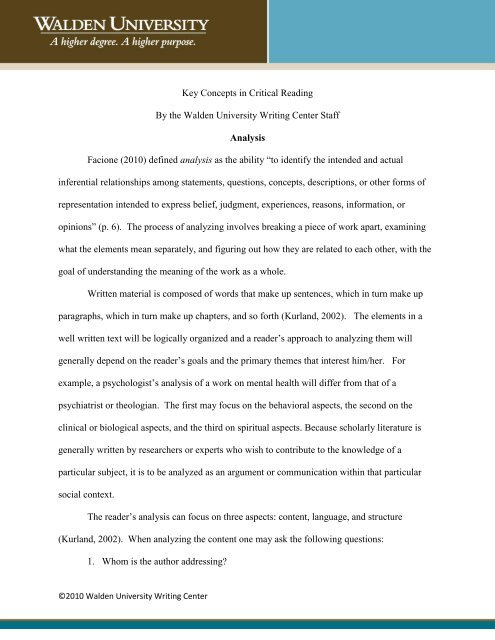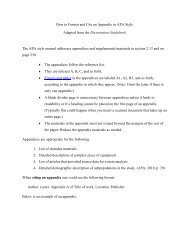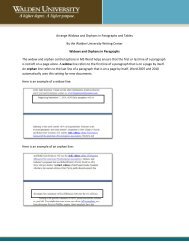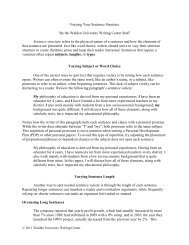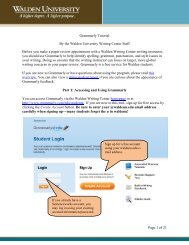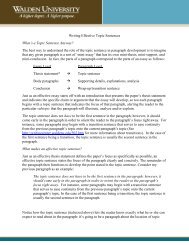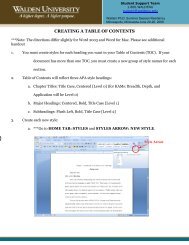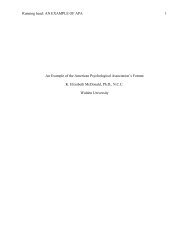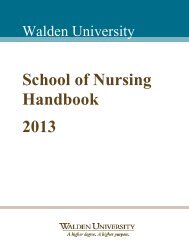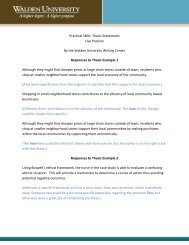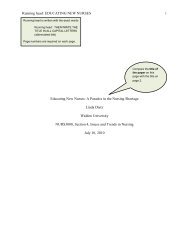Identifying Argument - Writing Center - Walden University
Identifying Argument - Writing Center - Walden University
Identifying Argument - Writing Center - Walden University
Create successful ePaper yourself
Turn your PDF publications into a flip-book with our unique Google optimized e-Paper software.
Key Concepts in Critical Reading<br />
By the <strong>Walden</strong> <strong>University</strong> <strong>Writing</strong> <strong>Center</strong> Staff<br />
Analysis<br />
Facione (2010) defined analysis as the ability “to identify the intended and actual<br />
inferential relationships among statements, questions, concepts, descriptions, or other forms of<br />
representation intended to express belief, judgment, experiences, reasons, information, or<br />
opinions” (p. 6). The process of analyzing involves breaking a piece of work apart, examining<br />
what the elements mean separately, and figuring out how they are related to each other, with the<br />
goal of understanding the meaning of the work as a whole.<br />
Written material is composed of words that make up sentences, which in turn make up<br />
paragraphs, which in turn make up chapters, and so forth (Kurland, 2002). The elements in a<br />
well written text will be logically organized and a reader’s approach to analyzing them will<br />
generally depend on the reader’s goals and the primary themes that interest him/her. For<br />
example, a psychologist’s analysis of a work on mental health will differ from that of a<br />
psychiatrist or theologian. The first may focus on the behavioral aspects, the second on the<br />
clinical or biological aspects, and the third on spiritual aspects. Because scholarly literature is<br />
generally written by researchers or experts who wish to contribute to the knowledge of a<br />
particular subject, it is to be analyzed as an argument or communication within that particular<br />
social context.<br />
The reader’s analysis can focus on three aspects: content, language, and structure<br />
(Kurland, 2002). When analyzing the content one may ask the following questions:<br />
1. Whom is the author addressing<br />
©2010 <strong>Walden</strong> <strong>University</strong> <strong>Writing</strong> <strong>Center</strong>
2. What is the author’s purpose<br />
3. What evidence is used to support the author’s argument<br />
4. What is the context of the work<br />
When analyzing the structure of the argument, one would ask questions such as:<br />
1. How is the argument built What comes first<br />
2. Do the points follow a logical sequence or timeline<br />
3. How did the author divide the sections<br />
4. Did the author present a problem and its solution<br />
5. Did the author use a compare and contrast analysis<br />
When analyzing the language, one would ask questions such as:<br />
1. What is the tone<br />
2. Does the word selection reveal any biases<br />
3. Is the language clear and vigorous<br />
As you analyze the text, it is also important to make connections between what you are<br />
reading and what you already know. Are any of the points made in conflict with your worldview<br />
or perhaps in conflict with the views of other respected scholars in the field Is the text<br />
significant If so, what makes it significant Does it make a worthwhile contribution to the<br />
field<br />
Inference<br />
The act of inferring is an important component of the critical reading process as it<br />
involves making judgments and drawing conclusions. A literacy study group created by The<br />
Project for School Innovation (n.d.) found that a reader’s ability to make correct inferences<br />
©2010 <strong>Walden</strong> <strong>University</strong> <strong>Writing</strong> <strong>Center</strong>
esulted in (a) better comprehension, (b) being more involved with the text, (c) becoming a more<br />
sophisticated reader, and (d) learning to think about the robustness of one’s thinking process.<br />
An inference (n.d.) is defined as “the act of passing from one proposition, statement, or judgment<br />
considered as true to another whose truth is believed to follow from that of the former.” Facione<br />
(2010) provided a more comprehensive definition; he defined it as being able to<br />
identify and secure elements needed to draw reasonable conclusions; to form conjectures<br />
and hypotheses; to consider relevant information and to deduce the consequences flowing<br />
from data, statements, principles, evidence, judgments, beliefs, opinions, concepts,<br />
descriptions, questions, or other forms of representation. (p. 6)<br />
When inferring, the central question is: “What is the author really saying” Inferences are made<br />
in everyday communication often without much thought. For instance, a husband may tell his<br />
wife “do not forget the girls.” From this simple statement the wife may infer several things that<br />
are not explicitly stated. She may infer that (a) he is referring to their two daughters, and/or (b)<br />
he is reminding her to pick them up from some place. Inference involves reading between the<br />
lines. To help her decide what her husband means, she relies primarily on the context, that is,<br />
what she already knows and what is most logical: he is her husband, and they have two teenage<br />
daughters who are out with friends. One could infer that by girls he is referring to random<br />
women; however, in this particular context, that inference though logical is unreasonable. Thus,<br />
for inferences to be accurate they must be sensitive to the context.<br />
Making inferences, particularly when one does not have the benefit of a close personal<br />
relationship with the author or intimate knowledge of the author’s views, can be tricky and it<br />
requires a great deal of care. Like the husband in the example above, writers are trying to<br />
©2010 <strong>Walden</strong> <strong>University</strong> <strong>Writing</strong> <strong>Center</strong>
communicate a point and the reader combines the words, assesses how they are related to each<br />
other, and tries to understand the ideas or meaning behind the words. Readers will generally<br />
rely on indicators or clues within the text and prior knowledge and assumptions to make<br />
inferences. This process is thus both intuitive and deliberate and care must be taken when using<br />
prior knowledge. Making inferences based primarily on the text will yield the most useful<br />
benefits for a reader of academic literature.<br />
Readers must also note that there is a difference between a reasonable inference and a<br />
correct one. One may make reasonable inferences based on a text and prior knowledge;<br />
however, these may not be correct. One way of ensuring that one’s inferences are correct is to<br />
review the evidence and try to determine whether specific reasons can be given to justify the<br />
conclusions that have been drawn. Inferences are, after all, speculations that are based on<br />
evidence. They are not quite the product of deductive reasoning so it is not unusual for two<br />
people to read the same material and make different inferences. The following example<br />
demonstrates this point: two people may see a man in tattered clothing lying in a gutter and from<br />
this one may infer that the man is homeless and the other that the man needs help; the first<br />
assumes only homeless people lie in gutters while the second assumes that a person lying in a<br />
gutter needs help (Paul, 1995). Note that Paul’s (1995) example also illustrates the intimate<br />
relationship between inferences and assumptions. The key to making valid inferences is thus a<br />
careful evaluation of the evidence. Kurland’s (2000) principle “the more evidence we have<br />
before us, and the more carefully we reason, the more valid our inferences” is apt. As you read<br />
and think through written material, it is important to also pay attention to the assumptions that<br />
underlie the inferences you make.<br />
©2010 <strong>Walden</strong> <strong>University</strong> <strong>Writing</strong> <strong>Center</strong>
Assumptions<br />
An assumption (n.d.) has been defined as a statement or fact that is taken for granted. It<br />
has also been defined as an element that “bridges the gap between an argument’s stated evidence<br />
and conclusion … a piece of support that isn’t explicitly stated but that is required for the<br />
conclusion to be valid” (Kaplan, 2008, p. 30). Although inferences and assumptions are not<br />
identical, they are related in that inferences often find a basis in what is assumed. Understanding<br />
assumptions is thus a crucial component of the critical reading process because it enables the<br />
reader to:<br />
1. Identify what is holding an argument together.<br />
2. Identify strengths and weaknesses of an argument.<br />
3. Find possible points of critique.<br />
Finding hidden assumptions can be tricky, especially when one is reading dense academic<br />
literature. However, identifying them is important because most logical flaws are rooted<br />
problematic assumptions. Here are a few strategies one can employ to identify assumptions:<br />
1. Evaluate the argument and determine whether it is valid. If it is not, what additional<br />
premises should be provided to make it so<br />
2. Look for the gap in the argument. Is there a piece of information missing that may<br />
explain how the author concluded X from Y<br />
3. Find a significant counterexample to the point made. This will enable one to identify<br />
what the author ignored.<br />
4. Assess the terms and categories. What meanings are ascribed to key terms Are the<br />
meanings reasonable and justified Do they reveal any biases<br />
©2010 <strong>Walden</strong> <strong>University</strong> <strong>Writing</strong> <strong>Center</strong>
Interpretation<br />
Ultimately, the goal of the reading process is to understand the overall meaning of the<br />
text. A writer may “paint a picture” for the reader, but it is ultimately the reader who ascribes<br />
meaning to what is read. The meaning ascribed to the text will be influenced by the reader’s<br />
biases, knowledge of other literature, inferences, and so forth. Interpretation has to do with<br />
making sense of or assigning meaning to something. Facione (2010) defined it as the ability “to<br />
comprehend and express the meaning or significance of a wide variety of experiences, situations,<br />
data, events, judgments, conventions, beliefs, rules, procedures, or criteria” (p. 5). It involves the<br />
ability to determine what is significant, recognize and describe a problem without bias, making<br />
distinctions between main ideas and subideas, and so forth (Facione, 2010). This skill is<br />
particularly important for graduate school students because of the sheer volume of reading that is<br />
expected of them and also because much of academic writing involves synthesizing the ideas of<br />
multiple authors. To be able to perform these tasks effectively, one must be able to interpret<br />
texts. A key skill involved in interpretation is the ability to summarize. When one is able to<br />
summarize each paragraph or each key point, one is on the way to effectively interpreting the<br />
overall meaning of the text. However, this is only the beginning as one must also be able to<br />
draw out the implications of the author’s arguments.<br />
Implications<br />
An implication (n.d.) has been defined as “the conclusion that can be drawn from<br />
something, although it is not explicitly stated.” In making connections between the text and the<br />
world, it is important to think about the possible consequences that might result if the author’s<br />
views are accurate. This however, must be done carefully in order to avoid falling into the<br />
©2010 <strong>Walden</strong> <strong>University</strong> <strong>Writing</strong> <strong>Center</strong>
slippery-slope problem, in which one assumes without warrant that a given action will result in a<br />
series of increasingly undesirable consequences. For instance, an instructor may argue that<br />
he/she cannot make an exception for a particular student because he/she will have to make an<br />
exception for all students. This, however, need not be the case as the conclusion/consequence<br />
does not logically follow from the premise/action.<br />
Implications provide useful material for critiquing or undermining arguments, so recognizing and<br />
drawing them out is an important component of the critical reading process. Drawing<br />
implications must begin with an understanding of the facts that are explicitly stated and the<br />
conclusions drawn by the author.<br />
©2010 <strong>Walden</strong> <strong>University</strong> <strong>Writing</strong> <strong>Center</strong>
References<br />
Assumption. (n.d.). In Merriam-Webster’s online dictionary. Retrieved from<br />
http://www.merriam-webster.com/dictionary/assumptionshow=0&t=1284489539<br />
Facione, P. (2010). Critical thinking: What it is and why it counts. Retrieved from<br />
http://www.insightassessment.com/pdf_files/what&why2006.pdf<br />
Implication. (n.d.) In the Oxford online dictionary. Retrieved from<br />
http://oxforddictionaries.com/view/entry/m_en_us1257344#m_en_us1257344<br />
Inference. (n.d.) In Merriam-Webster’s online dictionary. Retrieved from http://www.merriamwebster.com/dictionary/inference<br />
Kaplan, Inc. (2007). LSAT comprehensive program (2008 ed.). New York, NY: Kaplan<br />
Publishing.<br />
Kurland, D. (2010). The fundamentals of critical reading and effective writing. Retrieved<br />
August 27, 2010 from http://www.criticalreading.com/criticalreadingthinkingtoc.htm<br />
Paul, R. (1995). Why students and teachers do not reason well. In J. Wilson & A.J.A. Binker<br />
(Eds.) Critical thinking: What every person needs to survive in a rapidly changing world<br />
(3 rd ed., pp. 151-178). Santa Rosa, CA: Foundation for Critical Thinking.<br />
Project for School Innovation. (n.d.). Making inferences from text: A vital skill for reading<br />
comprehension. Retrieved June 10, 2010 from<br />
www.psinnovation.org/files/documents/LSGIntro.doc<br />
©2010 <strong>Walden</strong> <strong>University</strong> <strong>Writing</strong> <strong>Center</strong>


